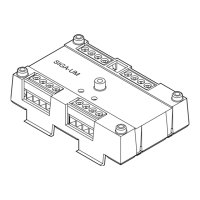2 / 8 P/N P-047550-1726-EN • REV 08 • ISS 05AUG16
Personality code 12: Active - NO latching (Class A). Same as
code 9 except that contact closure causes an active instead of
an alarm status, which is latched at the module. Code 12 is
typically used for monitoring supervisory and tamper switches.
Personality code 13: Alarm - two-wire smoke unverified
(Class B). Configures the module for monitoring two-wire
conventional smoke detectors (that do not require alarm
verification) and normally open contact initiating devices (e.g.,
pull stations, heat detectors, etc.) on the same circuit.
Personality code 14: Alarm - two-wire smoke verified
(Class B). Configures the module for monitoring two-wire
conventional smoke detectors (that require alarm verification).
Normally open contact initiating devices may not be mixed with
two-wire conventional smoke detectors.
Personality code 15: Signal - supervised output (Class A).
Configures the module for connection of a Class A output
notification appliance circuit (NAC). Code 15 is typically used
to control bells, speakers, etc.
Personality code 16: Signal - supervised output (Class B).
Configures the module for connection of a Class B output
notification appliance circuit (NAC). Code 16 is typically used
to control bells, speakers, etc.
Personality code 18: Alarm - soft short latching, European
Style C (Class B). A contact closure causes an alarm status
and a short condition causes a trouble status. Personality code
18 is typically used when a short condition must be
distinguished from an alarm condition.
Personality code 20: Alarm - two-wire smoke unverified
(Class A). Same as personality code 13, except that wiring is
Class A.
Personality code 21: Alarm - two-wire smoke verified
(Class A). Same as personality code 14, except that wiring is
Class A.
For personality codes 13, 14, 20 and 21
First SIGA-UM on a loop to go into alarm will maintain the 2
wire detector circuit voltage and current so that the 2 wire
detector can maintain its LED. Second SIGA-UM on the same
loop to get an alarm from a 2 wire detector will indicate the
alarm at the control panel but will reduce voltage and current
on its 2 wire circuit causing the detector LED to turn on and off.
Installation
Install this device in accordance with applicable national and
local codes, ordinances, and regulations.
WARNINGS
• Connecting a device that exceeds this module’s pilot duty
contact ratings may cause activation failure. This module
does not support capacitive loads. See “Specifications” on
page 7.
• The personality code for this device is factory set to 0.
This module will not operate until it is assigned a
personality code of 1, 2, 3, 4, 8, 9, 10, 11, 12, 13, 14, 15,
16, 18, 20, or 21.
• Electrocution hazard. Dangerous voltages may be present
at the module terminals even when power is shut off.
Table 1: Personality code listing information
Code Description UL 864 CAN/ULC-S527 EN 54-18
1 Alarm - NO latching (Class B) (default)
2 Alarm - NO delayed latching (Class B)
3 Active - NO nonlatching (Class B)
4 Active - NO latching (Class B)
8 Signal - dry contact output
9 Alarm - NO latching (Class A)
10 Alarm - NO delayed latching (Class A)
11 Active - NO nonlatching (Class A)
12 Active - NO latching (Class A)
13 Alarm - two-wire smoke unverified (Class B)
14 Alarm - two-wire smoke verified (Class B)
15 Signal - supervised output (Class A)
16 Signal - supervised output (Class B)
18 Alarm - soft short latching, European Style C (Class B)
20 Alarm - two-wire smoke unverified (Class A)
21 Alarm - two-wire smoke verified (Class A)

